Stories from an Oshima Tsumugi Weaver
Interview with Students and a Teacher at the Amami Oshima Tsumugi Technical Academy
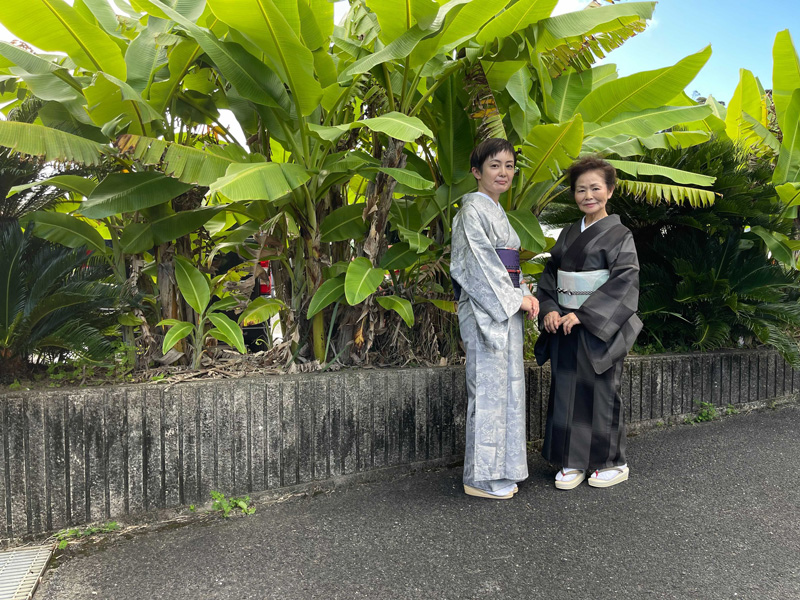
Renowned for its lightness, suppleness, and form-fitting comfort, Oshima Tsumugi has captivated countless admirers. Its defining features include the use of silk threads dyed with natural plant dyes and mud to achieve a deep, lustrous black, as well as its intricate kasuri (ikat) patterns—unparalleled in their precision and uniqueness.
Becoming a craftman of Oshima Tsumugi demands the acquisition of advanced skills. Moreover, with over 30 painstaking processes completed entirely by hand and through a division of labor, nurturing artisans at a company level remains a significant challenge today.
In the weaving process, one of the key stages in crafting Oshima Tsumugi, a single artisan works on a 13-meter bolt of fabric from start to finish. Depending on the pattern, progress can be as slow as just a few centimeters per day—a painstaking task that requires exceptional patience and dedication.
Interestingly, Amami Oshima is home to a school where locals can learn the skill of weaving the Oshima Tsumugi. One such institution is the Amami Oshima Tsumugi Technical Academy, which opened in July 2018. Supported as part of YAMATO Co.’s initiative to foster successors in the craft, the academy offers a two-year program to teach weaving techniques and prepare graduates to work as professional weavers.
On July 7, 2021, the school held its entrance ceremony for the current academic year, welcoming three new students. Presently, seven individuals are diligently honing their skills to become accomplished weavers.
We had the opportunity to speak with some of these remarkable individuals who are spinning Oshima Tsumugi into the future.
<The person who spoke>
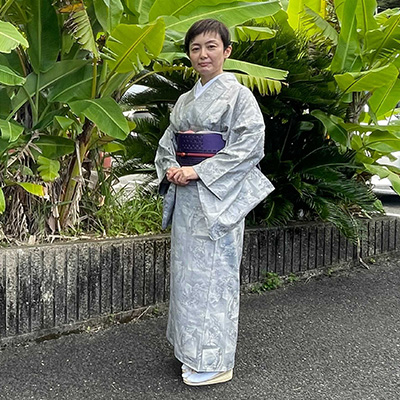
2nd year
Ui-san
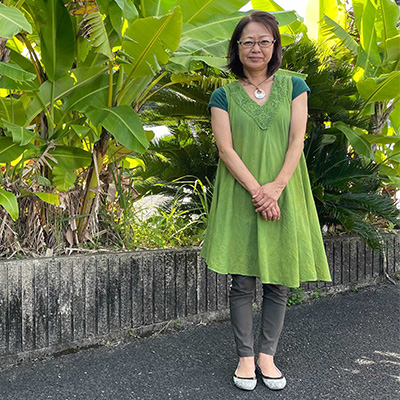
3rd year
Watanabe-san
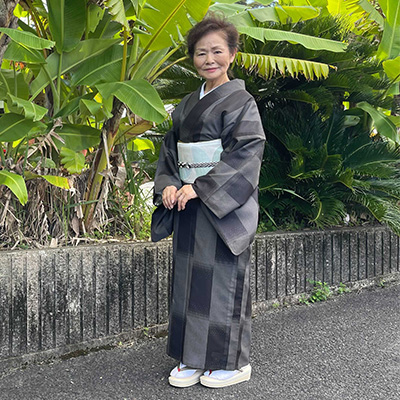
teacher
Sakae-san
― What made you decide to enroll at the academy?
- Ui-sanI’m originally from Amami Oshima, and as a child, my mother used to weave at home. I absolutely loved the atmosphere and the sound of the loom. It felt like a glimpse into the beauty of old Japan, and those memories left a lasting impression on me. I always thought, “One day, I’d like to try weaving myself.” Before I got married, I worked as a preschool teacher. That job often involved making handmade items, and through that, I realized how much I enjoyed creating things. Still, at the time, I never imagined I’d actually start weaving! (laughs)
- Watanabe-sanI used to live in Tokyo, but I’d always been drawn to the idea of island life. Six years ago, when my husband took early retirement, we moved to Amami Oshima. Years before, during a trip to Okinawa, I saw an ad for a course teaching how to weave minsa obi (the traditional textile from Okinawa). I was so intrigued and wanted to apply, but unfortunately, it was only open to local residents. After settling in Amami Oshima, I came across a newspaper article about this academy recruiting students. The moment I saw it, I knew I had to do it! That’s when I decided to enroll.
― What are you learning at the academy?
- Ui-sanWhen it comes to weaving, the key is to grasp the “feel” of it. It’s all about repetition—just weaving over and over, and gradually learning through your body.
- Watanabe-sanThe academy only lasts for two years, so I’ve actually already graduated. Now, I weave Oshima Tsumugi on the school grounds, and whenever I run into difficulties, I receive help from Natsuyo (Sakae)-sensei.
- Sakae-sanOshima Tsumugi can only be woven through one’s own feel, so it’s a constant learning process. Additionally, many weavers work from home, so in addition to teaching the technical skills of weaving, I also instruct on how to properly prepare the loom before weaving, so they can become independent artisans.
― What is the allure of Oshima Tsumugi?
- Ui-sanThe most allure aspects are its lightness and durability. Also, the patterns don’t go out of style, which I find very attractive. The Oshima Tsumugi I’m wearing today used to belong to my grandmother, and I think it’s wonderful that it can be passed down through generations like this.
- Watanabe-sanIt’s hard to express in just one word. Oshima Tsumugi is sometimes referred to as one of the “three great textiles of the world,” it is truly profound. I’m so happy to be able to learn this craft. When I lived in Tokyo, I’d seen Oshima Tsumugi at department store exhibitions, and while I admired it, I didn’t think I’d ever be involved with it. Now, having the chance to work with it, I’ve really grown attached to it.
- Sakae-sanNot only is Oshima Tsumugi lightweight and wearable, but it is also resistant to becoming disheveled. In terms of these qualities, I believe it’s unbeatable when it comes to kimono. Even if it rains a little, you can wear it with confidence, which is one of its great advantages. The old patterns of Oshima Tsumugi are also incredibly beautiful.
― What do you find most challenging when weaving Oshima Tsumugi?
- Watanabe-sanEverything is challenging! (laughs) Of course, the weaving itself is tough, but the most difficult part is the preparation of the loom. It’s really tricky. If you make even the slightest mistake with the order of the threads, it can cause big problems later on. It’s a basic step in weaving, but I think it’s something that most people struggle with. It requires a lot of concentration, so it’s definitely hard.
- Ui-sanEven when I feel like I’ve woven something perfectly, I might fail the next time I try to weave a new bolt of fabric… It’s not always smooth sailing. The most difficult parts are the “kasuri alignment” to express the patterns and the footwork involved. This is really a matter of feel…
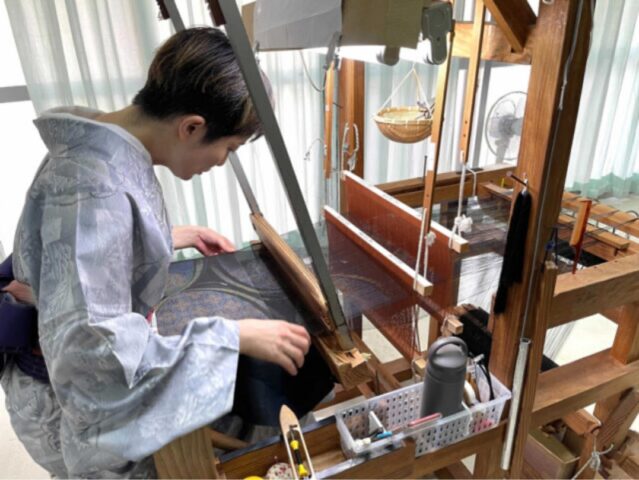
― What kind of Oshima Tsumugi would you like to create in the future?
- Ui-sanRight now, I’m weaving Oshima Tsumugi with a 9-maruki (※), which is really intricate and difficult. At first, the pattern alignment was so small that I couldn’t even see it, but strangely, as I kept weaving, I gradually got used to it, and now it’s starting to become clear. It’s only been about two months since I started, but my goal for now is to finish weaving this bolt of fabric.
- Sakae-sanI always encourage my students to try anything, even if it’s difficult. If you only weave simple patterns, you won’t improve. To weave Oshima Tsumugi, you need to have confidence in yourself, and I’m sure the students want to take on various patterns and challenges.
※Maruki: A unit that measures the number of vertical kasuri threads. One maruki equals 80 threads. The larger the maruki, the higher the density of the kasuri threads, resulting in more delicate and precise patterns.
― Finally, could you please share a few words with everyone?
- Ui-sanAs I weave each bolt of fabric, my attachment to it grows, and it starts to feel like raising my own child. I pour a lot of love into my weaving, so I hope people will treasure and wear it with care.
- Sakae-sanI often get asked, “Where should I wear this?” I always say, “Wear it anywhere and go out!” I often suggest wearing it at events like banquets. When paired with a formal obi, it’s perfect for special occasions. I’m sure everyone around you will appreciate it, too. It makes us very happy to see people wearing it often.
“There is a possibility that Oshima Tsumugi could eventually become extinct. However, if we act now, we can preserve Oshima Tsumugi for the future,” says Masahiko Maki, the principal of the Oshima Tsumugi Technical Academy and the chairman of the Oshima Tsumugi Cooperative Association.
He is dedicated to ensuring that the traditional industry of Oshima Tsumugi in Amami Oshima is passed on to future generations.
Oshima Tsumugi, which is produced through a division of labor, cannot become a finished product without the weavers. Moreover, without opportunities for customers to handle the products, the craft cannot continue.
Moving forward, YAMATO will continue to support the development of successors in the production area and will keep spreading the appeal of Oshima Tsumugi, connecting the production area with customers.

